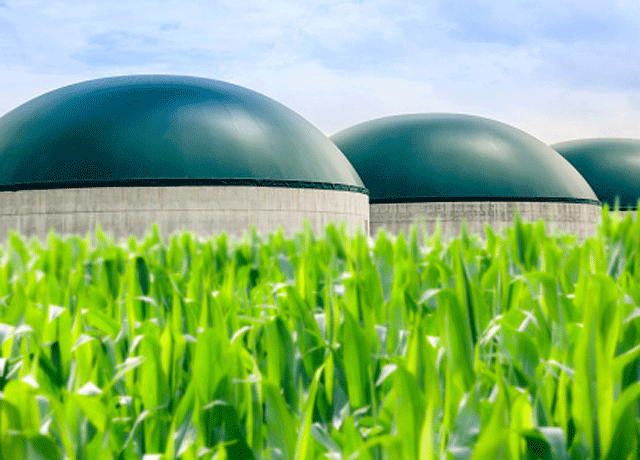Anaerobic Digestion (AD) and Biogas
Biogas is a gaseous fuel containing large amounts of methane (biomethane) which is produced by the anaerobic digestion of biological material under controlled conditions.
Please fill in the form with as much as information so that we can attend to your query appropriately.
Note that fields marked with * are mandatory.
Address:
HRS Process Technology Inc
840 Kennesaw Ave.
NW B-1, Marietta
Atlanta, GA 30060
United States
Email: info@us.hrs-he.com
Tel: +1 770 726 3540
Enquire today for a free quote
ANAEROBIC DIGESTION AND BIOGAS
As well as biogas, anaerobic digestion (or AD) also produces a co-product called digestate, which can be a solid, liquid or combination of the two.
HRS Heat Exchangers produce heat exchangers and other systems for use throughout the anaerobic digestion process, including:
- Exhaust gas cooling and energy recovery
- Feedstock and/or sludge heating
- Digestate/sludge pasteurization
- Digestate concentration and evaporation
- Thermal hydrolysis for enhanced gas production
EXHAUST GAS COOLING
Cooling and recapturing the heat from exhaust gasses can increase the efficiency of combined heat and power (CHP) plants used to generate electricity using biogas. Using HRS G Series heat exchangers with corrugated tubes on the exhaust recovers energy which can be used elsewhere in the plant, including feedstock and digester heating, pasteurization and digestate concentration.
FEEDSTOCK AND SLUDGE HEATING
The contents of the digester must be heated to maintain the ideal temperature for the bacteria to work. In addition, pre-heating the feedstock prior to putting it in the digester can reduce the amount of heat needed in the digester itself and improve the overall efficiency of the digestion process.
For such applications, HRS recommends DTI Series heat exchangers. Thanks to the corrugated tube in tube design, a high level of heat transfer is maintained, without the risk of obstruction or blockages associated with spiral heat exchanger systems, thus ensuring continuous operation in such a harsh environment.
FEEDSTOCK OR DIGESTATE PASTEURIZATION
Where required by legislation or quality demands (for example when treating animal by-products or producing digestate to the PAS110 quality standard) pasteurization may be required at some stage during the anaerobic digestion process. In addition, the operators of AD plants are increasingly seeing pasteurization as a way of demonstrating the quality of their digestate product and increasing its value.
The HRS DPS (Digestate Pasteurization System) have been designed to handle difficult feedstocks and to maximise energy efficiency regardless of whether the feedstock is pasteurised prior to digestion or after the digestate has been through the AD process.
DIGESTATE CONCENTRATION AND EVAPORATION
After digestion and biogas production, the digestate is separated mechanically into solid and liquid phases (the liquid phase is often treated as a waste stream but can be converted into a valuable product) which can then be used as a biological fertilizer, depending on the feedstock it can be rich in key fertilizer components (NPK), although the two streams have different storage and handling requirements.
In some cases, biogas operators must use and incur the additional cost of waste handlers to remove the digestate meaning extra opex cost.
The HRS DCS (Digestate Concentration System) applies an evaporation process to concentrate the digestate. This means that, whether your digestate creates a commodity that can be used or sold, reducing its volume will decrease the expense of storage, transport, application and disposal.
In a multi-stage evaporation process, the liquid digestate volume can be reduced by up to 80%. At the same time, unlike other technologies, the HRS DCS increases the content of crop nutrients whilst recapturing energy for use in the subsequent concentration phases, increasing energy efficiency and reusing the condensate elsewhere in the AD plant, preventing additional discharge to the environment.
THERMAL HYDROLYSIS FOR ENHANCED BIOGAS PRODUCTION
HRS has developed a patented process for the continuous thermal hydrolysis of digester sludge. This involves heating the sludge to 320-338℉ and a steam explosion step can be included for extra efficiency. This heat treatment changes the cell structure of the compounds, breaking down lignin and hemi-cellulose chains to create free sugars which are easier for the bacteria to digest. Consequently, residence times in the digester can be reduced. Using the patented Unicus Series scraped surface heat exchanger prevents fouling and makes continuous heat treatment possible.
BIOGAS DEHUMIDIFICATION SYSTEM
The HRS BDS Series is an efficient solution to cool and dehumidify biogas for combustion with two standard options. The system condenses up to 90% of the water contained in the gas, which is continuously separated before the lean biogas is ready for use. This is a necessary process for all bio-energy plants that use biogas as fuel in CHP engines.
A heat recovery step can be included as a standard option thus reducing energy costs up to 20%, Cold gas at 41°F is used to precool the incoming gas at 104°F, whilst raising the temperature of the dehumidified gas to approximately 97°F before use. A chiller is included to provide the energy required for the process.
The BDS comes complete with controls in a packaged ‘plug and play’ skid.
